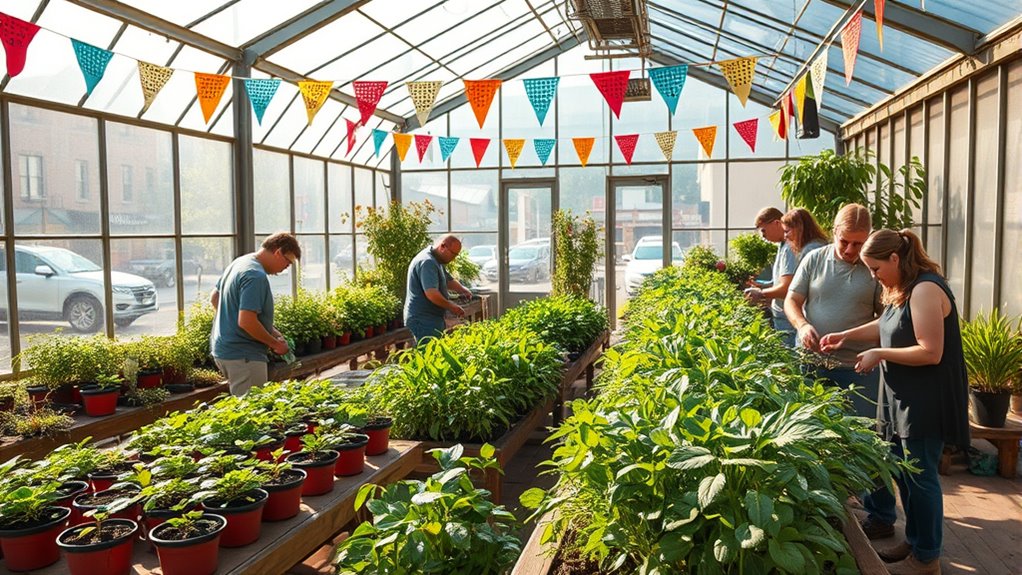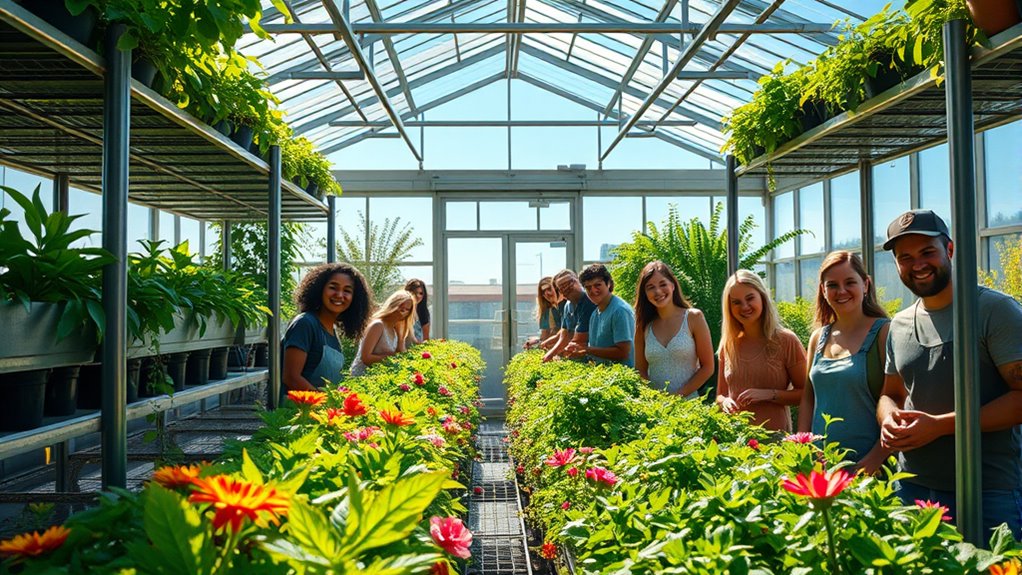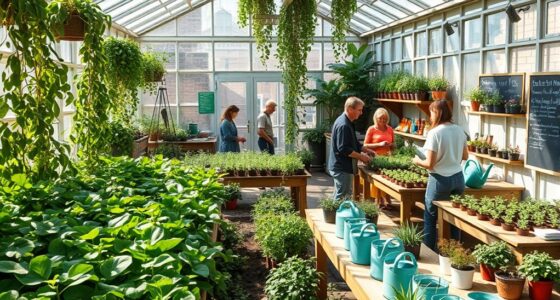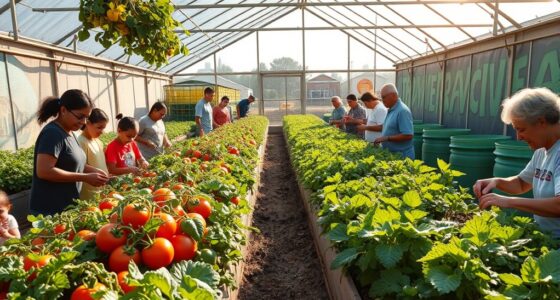To secure grants for your community greenhouse, research local agencies, foundations, and organizations that support sustainability and neighborhood projects. Clearly highlight how your greenhouse promotes eco-friendly practices, community involvement, and education. Build strong partnerships with local schools, businesses, and groups to strengthen your application. Craft a compelling proposal that aligns with funders’ priorities and showcases your project’s long-term impact. Continue exploring strategies to maximize your chances of funding success.
Key Takeaways
- Research aligned funders that prioritize sustainability, eco-friendly practices, and community development initiatives.
- Clearly demonstrate how your greenhouse incorporates sustainable methods like water conservation and organic farming.
- Engage the community through workshops, volunteer opportunities, and partnerships to strengthen support and participation.
- Build strong partnerships with local organizations, schools, and businesses, including letters of support to enhance credibility.
- Craft a compelling, data-driven proposal that aligns with funders’ goals, emphasizing sustainability, impact, and community benefits.

Are you looking to bring fresh, sustainable produce to your community? Securing funding for a community greenhouse can be a game-changer, but it requires more than just a good idea. To make your project a reality, you’ll need to understand how to access grants that support sustainable practices and foster community engagement. These grants are designed to fund initiatives that promote environmental stewardship while also encouraging local participation, making them an excellent resource for community-driven projects.
Start by researching grant opportunities from local government agencies, environmental organizations, and foundations dedicated to sustainability and community development. Many of these entities prioritize projects that align with their mission to promote eco-friendly practices and strengthen neighborhood ties. When applying, clearly demonstrate how your greenhouse will incorporate sustainable practices, such as water conservation, energy efficiency, and organic growing methods. Showing that your project will minimize environmental impact resonates with funders who value sustainability, increasing your chances of success.
Research grants from local agencies and foundations to fund sustainable, community-focused greenhouse projects.
Community engagement is equally important. Funders want to see that your project will actively involve local residents, schools, or community groups. Highlight your plans to host educational workshops, volunteer days, or community events centered around the greenhouse. Emphasize how your initiative will foster local pride, provide access to fresh produce, and serve as a hub for learning about sustainable agriculture. The more you can illustrate broad community support and participation, the more compelling your application becomes.
Another secret to securing grants is building partnerships with local organizations, schools, or businesses. These collaborations demonstrate your project’s community-centered approach and can strengthen your proposal. Partnering with established groups can also help you access additional resources and expertise, making your project more sustainable in the long run. When you include letters of support from these partners, it shows funders that your project has strong backing and will be well-maintained.
Finally, craft a clear, concise, and compelling narrative about your greenhouse project. Outline your goals, the sustainable practices you’ll implement, and how it will engage the community. Use data and success stories from similar projects to bolster your case. Additionally, understanding the importance of project sustainability can help tailor your application to align with funders’ priorities. Remember, grants are competitive, so make your application stand out by showcasing your passion and commitment to creating a greener, more connected community.
Frequently Asked Questions
How Can I Identify the Best Grants for My Specific Greenhouse Project?
You should start by researching grants that match your greenhouse project’s goals, focusing on grant eligibility criteria. Look for funding opportunities that align with your mission, target audience, and project scope. Review the grant descriptions carefully to confirm your project meets the requirements and fits the funding priorities. This way, you increase your chances of success by applying for grants that are a good fit and align with your project’s objectives.
What Are Common Mistakes to Avoid When Applying for Greenhousing Grants?
Think of grant writing like steering through a maze—you need to avoid common pitfalls. When applying for greenhousing grants, don’t overlook the importance of following instructions or neglecting key criteria; these are application pitfalls that can derail your chances. Avoid vague or incomplete proposals, and don’t forget to proofread thoroughly. Staying focused and detailed helps prevent mistakes, increasing your odds of securing the funding your community greenhouse needs.
How Long Does the Typical Grant Application Process Take?
The grant timeline varies, but typically, the application duration spans several weeks to a few months. You should plan for the review process to take around 60 to 90 days, depending on the organization. During this time, you’ll submit your application and await feedback. To stay on track, start early, follow deadlines precisely, and prepare all necessary documents in advance, ensuring a smooth and timely application process.
Are There Grants Available for Ongoing Greenhouse Maintenance Costs?
You might think grants only cover initial setup, but some are like magic wands for ongoing costs! Yes, there are grants available for maintenance funding and renewal, making your greenhouse thrive without burning out your budget. These grants help cover everything from supplies to repairs, ensuring your green space stays lush year-round. Keep an eye out for renewal opportunities, because consistent support can turn your community greenhouse into a flourishing oasis forever.
Can Small Community Groups Qualify for Large-Scale Greenhouse Funding?
You can absolutely qualify for large-scale greenhouse funding, especially if your community group demonstrates strong involvement and clearly shows how your project scales to benefit many residents. Funders look for projects with broad community support and growth potential. Highlight your group’s commitment, local engagement, and plans for expanding the greenhouse to make a compelling case for funding. Your project’s scalability and community involvement are key factors in securing larger grants.
Conclusion
Remember, securing support for your community greenhouse depends on dedication, determination, and diligent dialogue. By building bridges with local businesses, government grants, and generous donors, you’ll turn your green dreams into growth. Keep your passion persistent, and don’t let rejection deter you. With patience, persistence, and a proactive approach, you’ll pave the path to prosperity. So, stay steadfast, seek support, and succeed—because your community’s growth depends on your gumption and grit.










